Zidong Wu
Near-Field Wideband Beam Training Based on Distance-Dependent Beam Split
Jun 12, 2024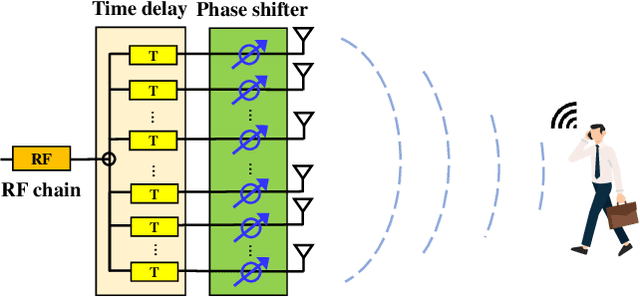
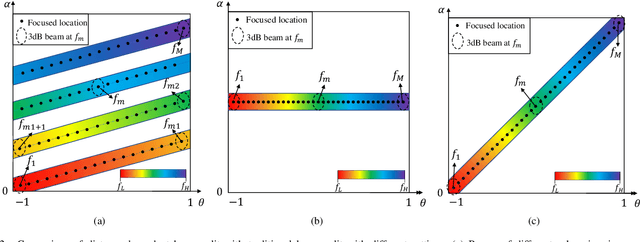
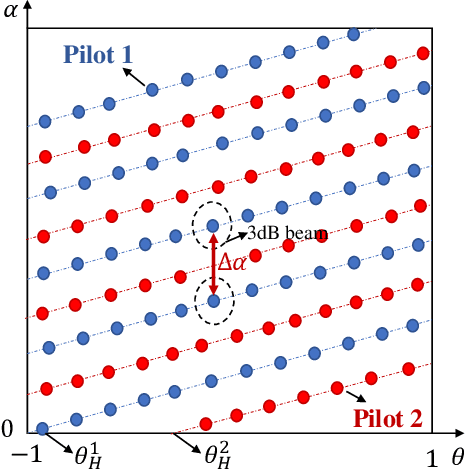

Abstract:Near-field beam training is essential for acquiring channel state information in 6G extremely large-scale multiple input multiple output (XL-MIMO) systems. To achieve low-overhead beam training, existing method has been proposed to leverage the near-field beam split effect, which deploys true-time-delay arrays to simultaneously search multiple angles of the entire angular range in a distance ring with a single pilot. However, the method still requires exhaustive search in the distance domain, which limits its efficiency. To address the problem, we propose a distance-dependent beam-split-based beam training method to further reduce the training overheads. Specifically, we first reveal the new phenomenon of distance-dependent beam split, where by manipulating the configurations of time-delay and phase-shift, beams at different frequencies can simultaneously scan the angular domain in multiple distance rings. Leveraging the phenomenon, we propose a near-field beam training method where both different angles and distances can simultaneously be searched in one time slot. Thus, a few pilots are capable of covering the whole angle-distance space for wideband XL-MIMO. Theoretical analysis and numerical simulations are also displayed to verify the superiority of the proposed method on beamforming gain and training overhead.
The Manifestation of Spatial Wideband Effect in Circular Array: From Beam Split to Beam Defocus
May 04, 2023Abstract:Millimeter-wave (mmWave) and terahertz (THz) communications with hybrid precoding architectures have been regarded as energy-efficient solutions to fulfill the vision of high-speed transmissions for 6G communications. Benefiting from the advantages of providing a wide scan range and flat array gain, the uniform circular array (UCA) has attracted much attention. However, the growing bandwidth of mmWave and THz communications require frequency-independent phase shifts, which can not be perfectly realized through frequency-independent phase shifters (PSs) in classical hybrid precoding architectures. This mismatch causes the beam defocus effect in UCA wideband communications, where the high-gain beams could not form at non-central frequencies. In this paper, we first investigate the characteristics of the beam defocus effect distinguishing itself from the beam split effect in uniform linear array (ULA) systems. The beam pattern of UCA in both frequency domain and angular domain is analyzed, characterizing the beamforming loss caused by the beam defocus effect. Then, the delay-phase-precoding (DPP) architecture which leverages the true-time-delay (TTD) devices to generate frequency-dependent phase shifts is employed to mitigate the beam defocus effect. Finally, performance analysis and extensive simulation results are provided to evaluate the effectiveness of the DPP architecture in UCA systems.
Location Division Multiple Access for Near-Field Communications
Jan 22, 2023Abstract:Spatial division multiple access (SDMA) is essential to improve the spectrum efficiency for multi-user multiple-input multiple-output (MIMO) communications. The classical SDMA for massive MIMO with hybrid precoding heavily relies on the angular orthogonality in the far field to distinguish multiple users at different angles, which fails to fully exploit spatial resources in the distance domain. With dramatically increasing number of antennas, extremely large-scale antenna array (ELAA) introduces additional resolution in the distance domain in the near field. In this paper, we propose the concept of location division multiple access (LDMA) to provide a new possibility to enhance spectrum efficiency. The key idea is to exploit extra spatial resources in the distance domain to serve different users at different locations (determined by angles and distances) in the near field. Specifically, the asymptotic orthogonality of beam focusing vectors in the distance domain is proved, which reveals that near-field beam focusing is able to focus signals on specific locations to mitigate inter-user interferences. Simulation results verify the superiority of the proposed LDMA over classical SDMA in different scenarios.
Enabling More Users to Benefit from Near-Field Communications: From Linear to Circular Array
Dec 30, 2022Abstract:Massive multiple-input multiple-output (MIMO) for 5G is evolving into the extremely large-scale antenna array (ELAA) to increase the spectrum efficiency by orders of magnitude for 6G communications. ELAA introduces spherical-wave-based near-field communications, where channel capacity can be significantly improved for single-user and multi-user scenarios. Unfortunately, for the widely studied uniform linear array (ULA), the near-field regions at large incidence angles will be reduced. Thus, many users randomly distributed in a cell may fail to benefit from near-field communications. In this paper, we leverage the rotational symmetry of uniform circular array (UCA) to provide uniform and enlarged near-field region for all users in a cell, enabling more users to benefit from near-field communications. Specifically, by exploiting the geometrical relationship between UCA and user with the spherical-wave model, the near-field beamforming technique for UCA is developed for the first time. Based on the analysis of near-field beamforming, we reveal that UCA is able to provide a larger near-field region than ULA in terms of the effective Rayleigh distance. Moreover, based on the UCA beamforming property, a concentric-ring codebook is designed to realize efficient beamforming in the near-field region of UCA. In addition, we find out that UCA could generate orthogonal near-field beams along the same direction, which has the potential for further improvement of multi-user capacity compared with ULA. Simulation results are provided to verify the feasibility of UCA to enable more users to benefit from near-field communications by broadening the near-field region.
Multiple access for near-field communications: SDMA or LDMA?
Aug 12, 2022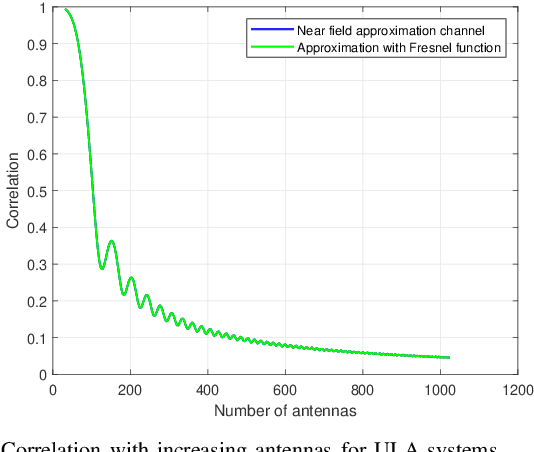
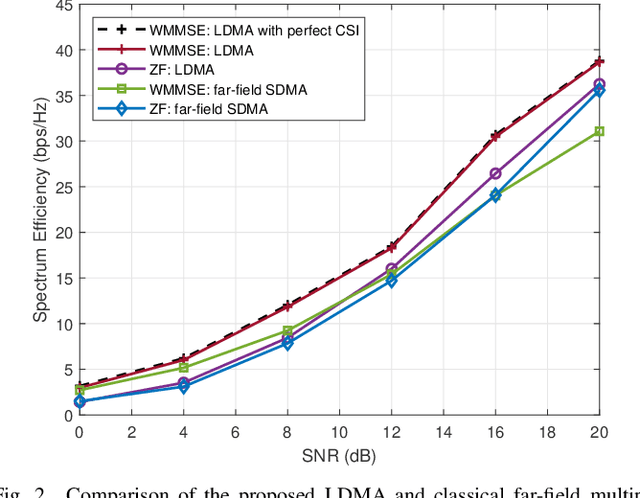
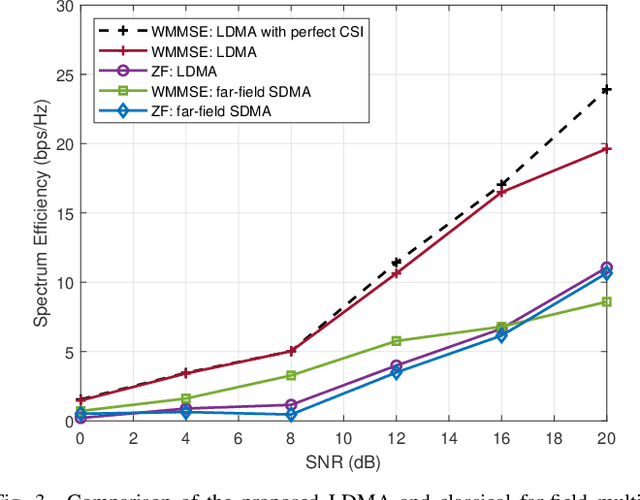
Abstract:Spatial division multiple access (SDMA) is essential in supporting multiple user transmissions in multiple-input multiple-output (MIMO) communications. Classical 5G massive MIMO SDMA relies on the orthogonality in far-field areas to distinguish multiple users residing at different angles, which fails to make full use of the spatial resources. With the dramatically increasing number of antennas, the extremely large-scale antenna array (ELAA) introduces the additional spatial resolution in the distance domain, which provides a new dimension for enhancing multiple accessibility in the near-field region. In this paper, we propose the concept of location division multiple access (LDMA), which elaborately exploit the spatial resources to serve multiple users at different locations. Specifically, unlike classical far-field beamsteering vectors which focus on specific angles, near-field beamfocusing vectors are capable of focusing on specific locations with managed leakage energy on other locations. The near-field focusing property could be leveraged to mitigate the interference from users at the same angle to enhance the multiple accessibility. Similar to the asymptotic angular orthogonality of far-field beamsteering vectors, the asymptotic orthogonality of near-field beamfocusing in the distance domain is investigated. Near-field codebook design is critical to support multiple transmission services. An alternate algorithm based on generalized Lloyd algorithm (GLA) and heuristic spherical sampling method is proposed for uniform planar array (UPA) codebook design. Based on the near-field codebook, LDMA scheme is investigated, comprising the beam training, uplink channel estimation and downlink transmission procedure. Simulation results verify the superiority of proposed LDMA scheme on spectral efficiency over different scenarios.
Near-Field Communications for 6G: Fundamentals, Challenges, Potentials, and Future Directions
Apr 12, 2022



Abstract:Extremely large antenna array (ELAA) is a common feature of several key candidate technologies for 6G, such as ultra-massive multiple-input-multiple-output (UM-MIMO), cell-free massive MIMO, reconfigurable intelligent surface (RIS), and terahertz communications. Since the number of antennas is very large for ELAA, near-field communications will become essential in 6G wireless networks. In this article, we systematically investigate the emerging near-field communication techniques. Firstly, the fundamental of near-field communications is explained, and the metric to determine the near-field ranges in typical communication scenarios is introduced. Then, we investigate recent studies on near-field communication techniques by classifying them into two categories, i.e., techniques addressing the challenges and those exploiting the potentials in near-field regions. Their principles, recent progress, pros and cons are discussed. More importantly, several open problems and future research directions for near-field communications are pointed out. We believe that this article would inspire more innovations for this important research topic of near-field communications for 6G.
Distance-Aware Precoding for Near-Field Capacity Improvement in XL-MIMO
Dec 29, 2021



Abstract:Extremely large-scale MIMO (XL-MIMO) communication is a promising technology to improve the capacity for future 6G networks. With a very large number of antennas, the near-field property of XL-MIMO systems becomes dominant. Unlike the classical far-field line-of-sight (LoS) channel with rank one, the significantly increased degrees of freedom (DoFs) are available in the near-field LoS channel. However, limited by the small number of radio frequency (RF) chains, the existing hybrid precoding architecture widely used for 5G is not able to utilize the extra DoFs in the near-field region. In this paper, we propose the distance-aware precoding (DAP) scheme to exploit the near-field effect as a new possibility for capacity improvement. Firstly, the DAP architecture is developed, where each RF chain can be flexibly controlled as active or inactive according to the distance-related DoFs. Then, a dedicated selection circuit is inserted to connect phase shifters and RF chains. Moreover, based on the developed DAP architecture, a DAP algorithm is proposed to jointly optimize the number of activated RF chains and precoding matrices to match the increased DoFs in the near-field region. Finally, simulation results verify that, the proposed DAP scheme can efficiently utilize the extra DoFs in the near-field region to improve the capacity.
 Add to Chrome
Add to Chrome Add to Firefox
Add to Firefox Add to Edge
Add to Edge